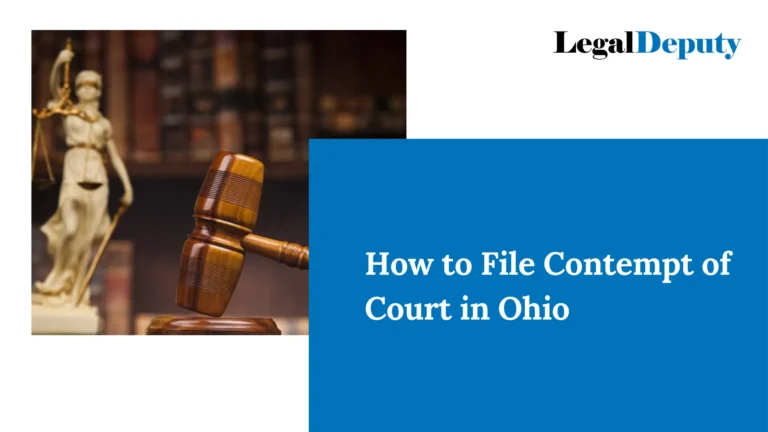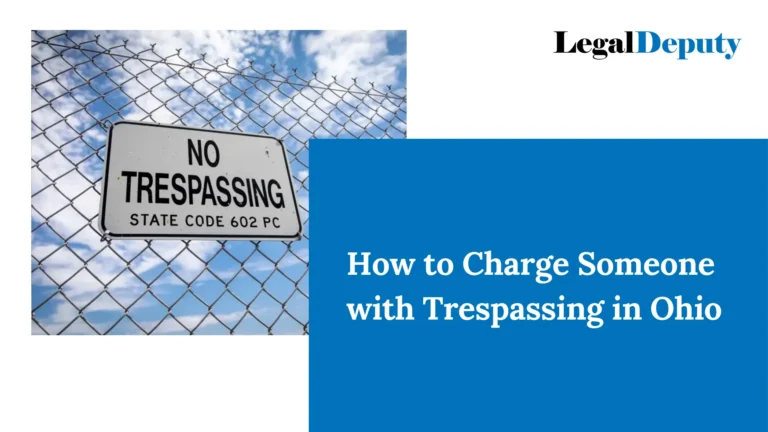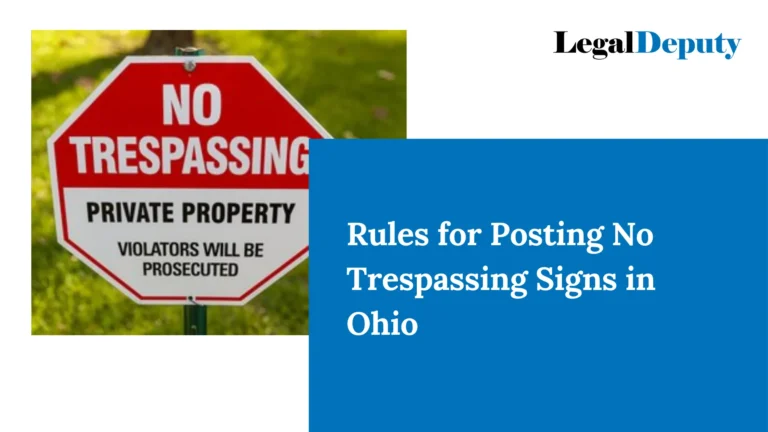How to Get an Annulment in Ohio? – All You Need To Know
Marriage is a profound commitment, but sometimes, circumstances arise that make the idea of annulment rather than divorce a compelling option. Annulment, often shrouded in mystery, is a legal process that renders a marriage null and void, as if it never existed. In Ohio, this alternative to divorce holds particular significance for those seeking a fresh start, a clean slate.
To embark on this journey, it’s crucial to navigate the intricate web of annulment with confidence and clarity. In this guide, we’ll unravel the annulment process step by step, demystifying the path to annulment in the Buckeye State, ensuring you understand its relevance, and can make informed decisions. Let’s delve into the world of annulment in Ohio – a legal solution that gives hope for a new beginning.
Understanding Annulment in Ohio
When the bonds of matrimony strain beyond repair, couples often turn to divorce as the default exit strategy. However, annulment, a less-explored legal avenue, can offer an entirely different solution. But what exactly is annulment, and how does it differ from divorce?
What is Annulment?
Annulment is a legal process that, when granted, effectively erases a marriage as if it never occurred. Unlike divorce, which terminates an existing marriage, annulment deems the marriage null and void from the beginning. This distinction is vital, for it can carry profound implications, both emotionally and legally.
Legal Grounds for Annulment in Ohio
In Ohio, as in many states, annulment is not a one-size-fits-all solution. To obtain an annulment, certain legal grounds must be established. These grounds are specific circumstances or conditions that make a marriage voidable. Common grounds for annulment in Ohio include:
Fraud or Misrepresentation: If your marriage was based on deceit or misrepresentation by one of the parties involved, you may have grounds for annulment. This could involve issues such as hidden criminal history or undisclosed previous marriages.
Bigamy: If your spouse was already married to someone else at the time of your marriage, your union is considered bigamous, making it eligible for annulment.
Impotence: If one party is physically incapable of consummating the marriage, Ohio law recognizes this as a valid reason for annulment. This condition must have been present at the time of the marriage.
Underage Marriage: If one or both parties were underage at the time of marriage without proper consent, an annulment is a potential remedy.
The Benefits of Annulment
The primary allure of annulment in Ohio lies in the fact that it retroactively voids the marriage. This means that legally, it’s as if the marriage never took place. This can have significant implications, especially when it comes to financial matters, inheritance rights, and the status of children born during the marriage.
Additionally, annulment can offer a fresh start with a clean slate, freeing both parties from the ongoing legal and emotional ties that divorce often entails.
In the following sections, we’ll delve deeper into the eligibility criteria for annulment and guide you through the essential steps to navigate the annulment process in Ohio. Understanding these intricacies is key to making an informed decision about your future.
Eligibility for Annulment
Understanding the legal eligibility criteria for annulment in Ohio is vital to determine whether this path is the right one for you. Here, we’ll dive into the specific requirements and who can file for an annulment, including residency prerequisites.
Eligibility Criteria
To qualify for an annulment in Ohio, several criteria must be met:
Legal Grounds: As discussed earlier, you must have a valid legal ground for annulment, such as fraud, bigamy, impotence, or underage marriage. These grounds are the foundation upon which your request for annulment is built.
Timely Filing: Annulment petitions in Ohio must be filed within a reasonable time frame. The timeframe can vary depending on the specific grounds for annulment, so it’s crucial to act promptly.
Who Can File for an Annulment?
An important consideration is who can initiate the annulment process:
Either Spouse: Either spouse can file for an annulment in Ohio, provided they meet the eligibility criteria. It’s not limited to just one party.
Guardian or Next Friend: In cases involving underage individuals who married without proper consent, a guardian or “next friend” can file for an annulment on their behalf.
Proper Representation: While you can file for an annulment on your own, it’s advisable to seek legal counsel or representation. An experienced attorney can guide you through the process, ensuring all legal requirements are met.
Residency Requirements
Ohio, like many states, has specific residency requirements to initiate an annulment. You or your spouse must meet one of the following conditions:
Either Party’s Residency: If either you or your spouse resides in Ohio at the time of filing, you can initiate the annulment process.
Place of Marriage: If the marriage took place in Ohio, you can file for annulment in the state, even if neither you nor your spouse is a current resident.
Understanding the eligibility criteria and residency requirements is crucial as you embark on the annulment process in Ohio. It’s important to note that annulment laws can be complex, and seeking legal guidance can make the process smoother and more efficient. Next, let’s delve into the process of filing the annulment petition, step by step.
Filing the Annulment Petition
Filing an annulment petition in Ohio is a crucial step in the process, and it’s essential to get it right. Here, we provide a step-by-step guide on how to file the annulment petition, including the necessary forms and documents, as well as why accurately filling out the paperwork is paramount.
Step-by-Step Guide to Filing the Annulment Petition
Consult an Attorney: Before diving into the paperwork, consider seeking legal counsel. An experienced attorney can guide you through the process, ensuring you meet all the necessary requirements.
Gather Required Documents: Begin by gathering the necessary documents, such as your marriage certificate, any evidence supporting your grounds for annulment (e.g., proof of fraud or bigamy), and any other relevant paperwork.
Obtain the Appropriate Forms: Ohio provides specific forms for annulment petitions. You can obtain these forms from your local courthouse or online through the Ohio court system’s website.
Fill Out the Petition: Carefully complete the annulment petition form. Provide accurate and detailed information, including the names of both spouses, the date and location of the marriage, the grounds for annulment, and any other required details.
File the Petition: Once the petition is completed, submit it to the appropriate court in Ohio. Typically, this is the court in the county where you or your spouse reside.
Pay Filing Fees: Be prepared to pay filing fees when submitting your petition. If you cannot afford the fees, you may be eligible for a fee waiver based on your financial circumstances.
Importance of Correctly Filling Out the Paperwork
Accurate completion of the annulment petition is critical for several reasons:
Legal Validity: Accurate and complete paperwork is essential to ensure the legal validity of your annulment request. Errors or omissions can lead to delays or even dismissal of your case.
Evidence of Grounds: The petition serves as a formal document outlining the grounds for your annulment. It’s essential to present a compelling case, supported by evidence, to justify the annulment.
Efficiency: Properly completed paperwork can expedite the annulment process. Mistakes can lead to delays, potentially prolonging an already emotional and legal journey.
Legal Counsel: If you’re unsure about any aspect of the paperwork, consult with an attorney. They can provide guidance, ensuring all requirements are met and potential pitfalls are avoided.
Filing the annulment petition is the initial step towards pursuing an annulment in Ohio. Once your petition is filed, the legal process will continue, involving court hearings, responses from the other party, and ultimately, the judgment of the court.
It’s a complex journey, but with the right guidance and proper paperwork, you can navigate it successfully. Next, we’ll explore the process of serving the annulment papers to the other party.
Serving the Annulment Papers
Once you’ve filed your annulment petition, the next crucial step is serving the annulment papers to the other party. This process ensures that they are aware of the annulment request and can respond accordingly. Here, we’ll explain how to serve the annulment papers in Ohio, discuss the different methods of service, and outline their legal requirements.
The Process of Serving Annulment Papers
Select a Process Server: To start, you must appoint a process server, typically a sheriff or a professional process server, to physically deliver the annulment papers to the other party.
Notification of Service: The process server will provide the other party with a notification of service, which is a document confirming that they have been served with the annulment papers.
Return of Service: The process server will also file a “return of service” with the court, documenting the date, time, and manner in which the papers were served.
Methods of Service and Legal Requirements
In Ohio, several methods of service can be used, but it’s essential to choose the appropriate one based on your situation and the legal requirements:
Personal Service: This method involves physically handing the annulment papers to the other party. It’s often the preferred method when feasible, ensuring direct notice.
Certified Mail with Return Receipt: If personal service is not possible, you can send the annulment papers via certified mail with return receipt requested. The return receipt provides proof of delivery.
Publication: In cases where you cannot locate the other party or they are avoiding service, you may be permitted to serve the annulment papers through a legal notice published in a newspaper.
Acceptance of Service: In some situations, the other party may voluntarily accept service by signing an acknowledgment or waiver of service, confirming their receipt of the annulment papers.
It’s crucial to adhere to legal requirements and document the service accurately. Any deviation from the specified methods or failure to follow the legal process can result in delays or complications in your annulment case.
Properly serving the annulment papers is a fundamental step in the legal process, ensuring that both parties have the opportunity to respond and present their side of the case. The response to the annulment petition is the next phase of this journey, where the other party can agree or contest the annulment. Stay tuned for the next section on “Response to the Annulment Petition” to explore what happens next.
Response to the Annulment Petition
After the other party has been served with the annulment papers, the legal process takes a significant turn. This is the stage where they have the opportunity to respond to the annulment petition and present their side of the case. In this section, we’ll delve into what happens after service, how the other party can respond, and the various options available to them.
What Happens After Service?
Once the other party is served with the annulment papers, they enter a critical phase of the process. They have a limited window of time, typically 28 days, to respond to the petition. The response allows them to express their stance on the annulment and whether they agree or contest it.
How Can the Other Party Respond?
When responding to the annulment petition, the other party has several options:
Agree to the Annulment: If both parties mutually agree that the marriage should be annulled, they can submit a joint request for annulment, simplifying the process.
Contest the Annulment: If the other party disagrees with the annulment request, they can contest it. This may involve presenting their own evidence and arguments to support their position.
Counterclaim for Divorce: In some cases, the other party may counterclaim for divorce rather than annulment. This can lead to a more extended legal process, with divorce proceedings.
Request for a Modification or Clarification: They can also request a modification or clarification of the annulment terms, such as property division or spousal support.
Options Available to the Responding Party
During this phase, the responding party can also explore the following options:
Legal Representation: Seeking legal counsel is advisable at this point. An attorney can help the responding party navigate the legal process, understand their rights, and present their case effectively.
Negotiation: In some instances, parties may engage in negotiations or mediation to reach an agreement outside of court.
Court Hearings: If the annulment is contested, court hearings may be necessary. This is where both parties present their evidence, and a judge ultimately makes a decision.
Appeal: If either party is dissatisfied with the court’s decision, they have the option to appeal the ruling.
The response to the annulment petition is a critical juncture in the process, where the other party’s involvement and decisions significantly influence the course of the case. It’s important for both parties to understand their options and seek legal guidance when necessary. The final phase of this journey involves court proceedings and the ultimate judgment of the court, which we’ll explore in the next section.
Court Process and Hearings
The court process for an annulment in Ohio is a critical phase where the legal proceedings move from paperwork to courtroom hearings. In this section, we’ll walk you through the court process, explain the role of hearings and court appearances, and provide valuable tips on how to prepare for this significant step.
The Court Process for Annulment
Pleadings and Filings: After the initial response and any counterclaims, both parties may engage in further legal filings, including financial disclosures and other relevant documents. It’s essential to comply with court orders and deadlines during this phase.
Discovery: Discovery is a process where both parties may request information and evidence from each other to support their case. This phase can involve depositions, written questions, and document requests.
Pretrial Hearings: The court may schedule pretrial hearings to review the case’s progress, discuss any potential settlements, and set the stage for the final hearing.
Final Hearing: The final hearing is the culmination of the court process. It’s an opportunity for both parties to present their case, including evidence, witnesses, and arguments. The judge will make a decision based on the evidence and legal arguments presented.
Role of Hearings and Court Appearances
Hearings and court appearances play a pivotal role in the annulment process. They provide a platform for both parties to state their case, present evidence, and clarify any disputed issues. The judge presiding over the case will carefully consider the testimony and evidence presented during the hearings.
Tips for Preparing for a Court Appearance
Consult with Your Attorney: If you have legal representation, consult with your attorney extensively before the hearing. They can help you understand the legal process, your rights, and the specifics of your case.
Organize Your Evidence: Ensure all relevant documents, records, and evidence are well-organized and easily accessible. This will streamline the presentation of your case.
Review Your Testimony: If you are a party or a witness, review your testimony and responses to potential questions. Be clear and concise when presenting your side of the story.
Dress Appropriately: Dress in a professional and respectful manner for the court appearance. This demonstrates your seriousness and respect for the legal process.
Maintain Composure: Stay composed and respectful during the hearing. Emotions can run high during legal proceedings, but maintaining a calm demeanor is essential.
Follow Court Procedures: Abide by the rules and procedures of the court, including punctuality, addressing the judge with respect, and adhering to courtroom etiquette.
The court process and hearings can be a challenging and emotional phase of the annulment journey. Preparation, legal guidance, and a clear understanding of the process are crucial for presenting your case effectively. Stay tuned for the next section where we’ll explore the final steps in the annulment process, including the judgment and the potential impact on your future.
Finalizing the Annulment
The annulment process in Ohio, like all legal journeys, has a conclusion. It’s a culmination of the steps you’ve taken to end a marriage and the legal implications that follow. In this section, we’ll explore the final steps in the annulment process, including obtaining a decree of annulment and the significant legal implications that come with it.
Obtaining a Decree of Annulment
Once the court process, including hearings and legal arguments, is complete, the judge presiding over your annulment case will issue a decree of annulment. This decree serves as the formal legal document that declares your marriage null and void. It’s a significant moment, marking the official end of the marital relationship.
Legal Implications
The decree of annulment carries various legal implications:
Marital Status: The annulment decree legally voids the marriage, effectively restoring both parties to their pre-marital status. This means that, in the eyes of the law, the marriage never existed.
Property Division: Property and assets acquired during the marriage may be treated as separate property and not subject to division. However, financial matters can vary based on the specifics of the case.
Spousal Support: Annulment may affect spousal support or alimony, as the legal foundation of the marriage is dissolved.
Child Custody and Support: If there are children involved, issues related to child custody and support will be addressed separately, similar to divorce proceedings.
Retirement and Benefits: The annulment decree may have implications for retirement accounts, pensions, and other benefits that may have been shared during the marriage.
Tax Implications: It’s important to consult a tax professional to understand any potential tax implications that may arise from the annulment, especially if there are shared assets or financial arrangements.
The end of a marriage through annulment is a significant legal event with real consequences for both parties. It’s essential to fully comprehend these implications and seek legal counsel to navigate any challenges that may arise.
A Fresh Start
While annulment signifies the conclusion of one chapter, it also represents a fresh start. For many, it provides an opportunity to move forward without the label of divorce and the associated stigma. It’s a chance to begin anew, unburdened by the legal ties of a marriage that is no longer valid.
In conclusion, understanding the annulment process in Ohio and the final steps involved is vital as you embark on this journey. The legal implications and the potential impact on your future make it crucial to navigate this process with care, knowledge, and legal support. Your annulment journey is unique, and with the right guidance, you can look forward to the next chapter with clarity and confidence.
Frequently Asked Questions (FAQs)
Navigating the annulment process in Ohio can raise many questions and concerns. Here, we address some of the most frequently asked questions to provide clarity and guidance.
1. What’s the Timeline for an Annulment in Ohio?
The timeline for an annulment can vary depending on the complexity of the case, court schedules, and whether the annulment is contested. In Ohio, it typically takes a few months to a year to complete the process.
2. How Much Does Annulment in Ohio Cost?
The cost of an annulment in Ohio can vary widely. Filing fees, legal representation, and other associated costs can add up. It’s essential to consult with an attorney to get an estimate tailored to your specific situation.
3. Can I Get an Annulment Without Legal Representation?
While it’s possible to pursue an annulment without legal representation, it’s highly advisable to consult with an attorney. Annulment laws can be complex, and an attorney can guide you through the process, ensuring all legal requirements are met.
4. Can I Annul a Long-Term Marriage in Ohio?
Annulments are typically reserved for marriages of short duration, where specific legal grounds are met. For long-term marriages, it’s more common to pursue a divorce.
5. Will I Need to Attend Court Hearings?
Court hearings are a typical part of the annulment process, especially if the annulment is contested. Both parties and their legal representatives may need to appear in court to present their case.
Remember that each annulment case is unique, and the answers to these FAQs can vary based on the specific circumstances. Legal guidance is essential to navigate the intricacies of your case and make informed decisions throughout the annulment process in Ohio.
Conclusion
In the intricate landscape of annulment in Ohio, we’ve unraveled the essential steps to guide you through this unique legal journey. Annulment, distinct from divorce, offers a fresh start by legally erasing the marriage. Understanding the eligibility criteria, legal grounds, and the court process is crucial.
Obtaining a decree of annulment is a defining moment. It signifies the end of the marriage and holds legal implications for property, spousal support, and more. However, this path is not without its complexities.
The key takeaway is clear: Seek legal advice. Annulment laws can be complex, and an experienced attorney is your best ally in navigating this process. With their guidance, you can make well-informed decisions and ensure the legal requirements are met.
Take the first step toward your new beginning with confidence. Your unique annulment journey awaits, and by seeking the right legal support, you can set forth on this path with clarity and a vision for a brighter future.
Disclaimer:
The information provided on this blog is for general informational and educational purposes only. It is not intended as legal advice or a substitute for professional legal consultation. The content may not reflect the most current legal developments or changes in legislation.
While we strive to provide accurate and up-to-date information, the law is a complex and dynamic field, and its application can vary based on individual circumstances. Therefore, we recommend consulting a qualified attorney or legal expert for personalized advice specific to your situation.
Use of this blog and its content does not establish an attorney-client relationship. The blog’s authors and publishers are not responsible for any actions taken based on the information provided herein.
Always consult with a licensed attorney for guidance on legal matters, and do not rely solely on the information presented on this blog. Your legal issues deserve careful consideration and personalized attention from a legal professional.





